c o m i n gx i n t ox b e i n g |
part two of six - February 2007
in two sections
|
| GAUDI. Gaudi and Barcelona. How did his work and this culture come about? How did he get his work built? What conditions supported this effort? Blocked it? How has his work held up and been maintained for over a 100 years? What is the social message today? How does this relate to my practice model of architecture? What does it mean to UniCredit, the NavCenter, its work and the ability to deal with systemic issues? What is the relevance of his work to the world we are building today? |
| Worthy questions for a time of rest and reflection. |
| Is Gaudi’s vision of architecture congruent with the consumer society? I think not. Mine is not and this is most likely why my built work has been restricted to NavCenter environments which are about the transformation of the status quo not building according to it. All my attempts at “secular” building has met a quick death as recently as the very day that I write this. Gaudi gave up on commercial work after too many arguments and conflicts with clients. He devoted the last 14 years of his life to his Cathedral - his became a religious vision. In his case, the social framework was entirely different from mine. Many of the arguments he had with clients and the public, however, are the same differences I have today. Mine is not a religious vision it is a philosophical one. I call myself the last Humanist - at first there was humor meant in this; not so much anymore. With Humanism being blamed for all of the excesses of out present society it seems that any Humanist insight and position is fading from view. Fundamentalism, of all kinds, and hedonism seem to be battling it out for dominance. In the public discourse, there are few other viewpoints. |
| The primary secrete of Gaudi is his exclusive focus on his art. There was nothing else that distracted him. This is one form of the “self-aware and reflective” life. It is this lesson, I think, that I will be coming back to as I reflect upon his work and see what insights this brings to the the question I have asked in this introduction. |
|
...Week Three - 04/Feb to 10/Feb/07
Discovery and Reflection |
| Gail and I were in Barcelona from Friday afternoon to Wednesday morning - a short stay for this city. It was a wonderful time - we did lots of walking and I did a great deal of thinking. Internet connection was restricted to daily morning sessions at the local Starbucks coffee shop so there was a sense for me of isolation from the busy world I left. On Thursday, we flew to another part of Spain for more exploration and business meetings - more about this later. First, Gaudi and Barcelona. |
| The first thing you realize upon arriving in Barcelona is that Gaudi has become a commodity and and enterprise - he is big business today. This is a paradox of course given how he lived - particularly in his later years - and what he stood for in the totality of his effort. This is a little more sensible when you consider how the majority of his nonreligious work was funded and who it was built for. For a period of time, Gaudi was the most eccentric and expensive architect of the rising middle class who were bent on outdoing one another in the demonstration of their wealth and taste. In this way he already was a consumer item and I think this ultimatelty wore him down. With the exception of his long relationship with Count Guell, this Gaudian-middle-class marriage of convenience was an unlikely and ultimately unhappy relationship. Architecture had long be a creature of patronage and it still is today only under a new disguise. The second thing - an astounding thing really - about Gaudi is that he managed to grow to maturity and establish his cannon and “voice” with just a few works - about a score of built projects. This is in sharp distinction, with a few notable exceptions, with modern practice. What is typical of any great work is that he grew up in a time and place which was able to foster it and that he was connected to a loose but broad social movement. There were many threads in the arts, philosophy and politics that connected to his work and visa versa. The fourth point is again unusual. Gaudi, especially as he grew older, took his own persona out of the process and public spotlight. In the end, he refused to be a “star” architect. Bruce Goff was like this. Shindler to a degree. Few other notables in architecture have followed this path although I think it is a true statement that the organic school as produced more than its fair share of “modest” practitioners. |
| What impressed me most about Gaudi’s work, other than the sheer genius, brilliance and innovation of it, is his materiality and how well his works are standing the test of time. This man built to last and I think this is a more significant key to the “mystery” of Gaudi than has been realized. Every surface of his buildings was given attention and the details are case specific not standard to a type and based on a common solution. Gaudi was a Master Building not an architect as the term is defined and practiced today. He was also a great engineer and structure was an integral aspect of his esthetic. He did not “hang” his art “on” mundane structures unrelated to a visual concept as is now so common. His integration of form and function was extraordinarily high and his innovation breathtaking. When faced with a problem that would have lead an average architect to a mundane compromise, Gaudi simply invented a totally new solution seemingly out of thin air. |
| Below are some image and notes on Gaudi and his work. For a more complete review go to my piece on his work [link: gaudi]. |
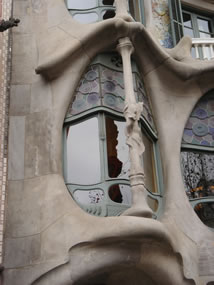 |
Every Gaudi structure shown here, while open to the public with accompanying museum and book store, is still used for its intended purpose. The younger ones are a hundred years old and several are older. There has been some reuse providing shops on the first floor of several. The Temple De La Sagrada Famila is still under construction. As construction, these buildings are remarkable for how well they are built, have stood the test of time, have been maintained, and in recent years, restored.
These picture show only four of Gaudi’s projects, mostly from his later period, with only a few pictures of each. Yet, the remarkable variety of forms, engineering integration and practical inventiveness can be easily seen. The material richness of the buildings is one of their outstanding characteristics. As varied as they are in purpose and solution there is a uniform world view which permeates all. Each is a total and complete world of its own and each relates to the other, to Barcelona and - to a significant degree - defines barcelona.
Gaudi was one of the few architects, in modern times, who actually took a direct and active role in the building of his works. This allowed an attention to detail not possible with drawings alone. It also infused the kind of energy into the buildings that is usually reserved for art made on a more intimate scale. I have observed, in my own work, that this attention - all other aspects being equal - produces a significant difference in the quality of the result and in the response of those who experience the “completed” environment. This was demonstrated in the building of the Unicredit NavCenter which is the first time I had committed this level of involvement since the making of the Palo Alto knOwhere Store in late 1997 - nearly a decade ago. It is clear to me that the future works I have in mind will require this approach. I have always been disposed to build this way - and have often in the past - and advocated it; yet, my recent experiences have reinforced in my mind the absolute requirement of this approach. To be clear: it is not just the result in the technical and mechanical sense - it is the feeling that finds its way into and permeates the structure. This is clear in the many works profiled in this writing. It is factor of how these works were built, used and in many cases rebuilt over long periods of time. An entirely different sense of architecture emerges out of this process than the “secular,” linear, “commercial” approach of today [link: real estate].
Gaudi saw his work as an essentially religious act. If you go to the root of this word you will discover that it means “to connect back.” I feel the same way just not necessarily in the framework of a dogma. I also believe a work must lead forward [link: mrs pew]. Great works of authentic architecture have the power to transform human perception and experience [link: mt thesis]. To do this they must be designed and built right and also used and evolved properly over a lengthy period of time. Our modern attitude of seeing buildings as a utility - only, and a commodity - commercially, along with our present real estate practices, produces monuments to humanity’s baser expressions at the expense of providing an exalted, transformational experience of what we individually and - as a species - can become. I beiieve that Gaudi knew this and it was this inpuse that determined his architecture, apporach to practice, and the personal decisons that governed his life.
What is interesting about Gaudi is that his work is both unique - it still stands alone as a highly individualistic expression - and how he fits within a long, centuries old, tradition and within a period when this very tradition - which he started within - was being challenged and transformed. As his work evolved, he became increasingly controversial and the conflicts between him and his clients increased. He ultimately abandoned secular work and devoted his last years to his temple. He turned away from the very life-style and client base that supported his early work. The exact details of this are shrouded in mystery as Gaudi was an intensely private person. He published little and what writings and drawings did exist were lost during the Spanish revolution.
Like most of Organic Architecture, his work cannot be successfully copied. It is bound by time, place and circumstance - as it should be. It is, however, one expression of not only an approach to architecture that is steeped in universal principles - but also a body of work which became a testament to life itself. Gaudi searched for the underpinnings that made Nature what it is and sought to employ this harvest as a means to the making of human habitat. And, like all true artists, he was an expression of his time and of a world that was not yet but could be. At this, he was supremely successful. I expect, today, Gaudi and his approach is considered by the profession to be an exception from the past. If we are going to have a viable architecture, I suggest that Gaudi be studied as a precursor to a new approach to the art of making architecture.
|
|
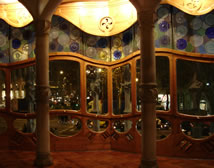 |
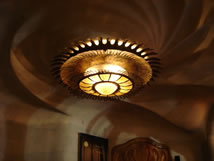 |
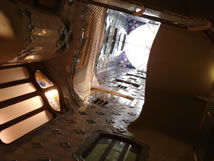 |
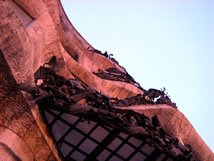 |
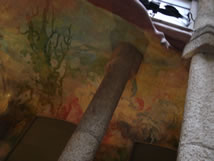 |
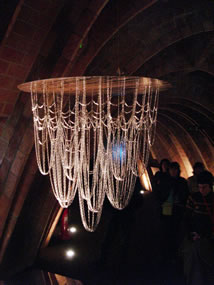 |
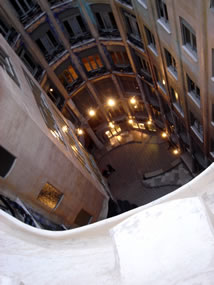 |
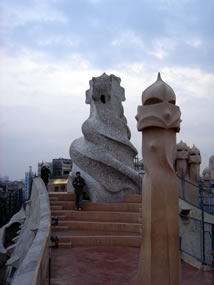 |
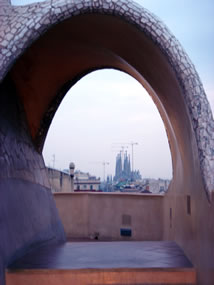 |
 |
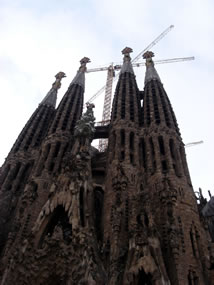 |
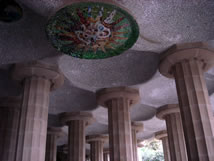 |
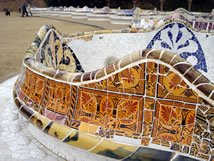 |
| There is more to Barcelona than Gaudi and we saw many other works of interest. Two that stand out were our trips to the Music Museum and a hotel (I do not know what the building originally was) bar which is one of the most comfortable, subtitle and complex rooms I have ever seen. |
With the exception of the last photo, which is the hotel near where we stayed, these pictures are all from the Medieval old town section of Barcelona. Here, buildings have been built, modified and used for hundreds of years right up to today.
There are few environments which have the amenity of a well preserved/restored Medieval town that has been carefully retrofitted with modern technology. The Pattern Language of these towns is extraordinary. The streets are great social spaces. There are abundant private courts. Light and ventilation is handled well and materials are rich with texture and history. Add modern sanitation to this, electricity and electronics, steel and glass where appropriate, sensitive (not a copy) additions, and the results are often an architecture far richer than what is built from scratch today. Certainly more enduring.
We walked for miles in Barcelona. I think it was Ian McHarg who said the measure of a city’s greatness is the degree you want to walk in it. Barcelona invites walking and I do not think you could absorb its variety in five years of continuous exploration. This is not because of size. It is the richness of human experience that Barcelona expresses and supports that attracts so.
While in Barcelona I reduced my contact with the outer world to the minimum possible. The eliminated distractions and left my mind free to respond in this place and moment. This became a period of absorbing and reflection. The many pictures I took were shot as a reflex without a focused intent an prescribed purpose. 5 mega-pixel cameras which fit easily into a pocket and palm of a hand are such a joy. Gail and I had some good conversations but I think the time for both of us was more a meditation and a taking in rather than mental processing and putting out. This was deep time and it has taken a lengthily process to pull it out and objectify it in this documentation.
The hotel bar, shown in the last picture here, is a surprising space. It is a corner room which looks out onto a busy barcelona intersection. We came here twice because the ambiance was so pleasant and the subtle way that it mediated between private and social space so effectively. The arrangement between the exterior fenestration, the interior columns and the arches was peaceful yet so intriguingly complex that, after several hours a a few glasses of rich Spanish wine, I was still probing its puzzles - a rare pleasure for someone who can usually grasp and architectural solution in an instant. |
|
|
|
|
|
|
|
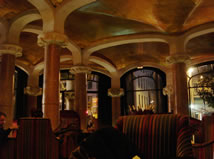 |
| Extremadura was next on our exploration of Spain. We were invited there by a foundation doing a fine job in support of efforts at recreating the culture and economy of the region. We were treated, by a most gracious host, to three days of dialog, visiting historical sites, and meeting people engaged in the work of the foundation and working with the foundation in support of similar missions. Below are a few pictures and comments regarding this extraordinary experience. For more go to my story on this visit [link: extremadura]. I will say nothing about the food other than you have not eaten if you have not visited this region with a host who can show the way. |
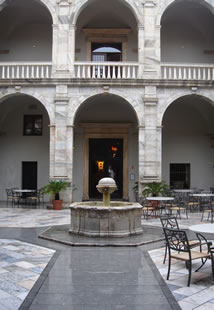 |
A four star hotel in a restored royal palace that is part of a chain across Spain. A restored palace, where a Conqueror’s family lived for hundeds of years, that is now an active foundation and research facility, with visiting scholars, studying the history and relationship between Spain and the New World. An abandoned industrial building now a sparkling restaurant overlooking the city. A defunct cement factory to become an incubation center - both symbol and tool for a renewing knowledge economy. A once prosperous Medieval city, where our host played in as a young boy - when it was nearly empty - now alive again with shops, restaurants and homes and religious facilities that have been continuously in use for hundreds of years. A vast Roman site with baths, circus, theatre and homes buried and forgotten - rediscovered a century ago - now a national museum with the theatre used as it was in the first century. A river and trade center for 2,000 years; Roman, Christian, Islamic, medieval, industrial - all gone with a modern city emerging from it all. Vast farmlands cattle, sheep cork - once again connected to the major cities as it was in ancient times - reawakening. This is the Extremadura Region of Spain. Rich in history. Rich in prospect. At a crossroads of time.
This description and these pictures do not even begin to tell the story of three days of sensory overload, engaging dialog and a renewed sense of the continuity of past, past and future. Here is one version, in a nutshell, of Western Civilization’s story - including the profound Islamic influence - and the issues it faces today. Are we going to replay history or reinvent ourselves [link: 4 step recreation model] and our future?
This was my first exposure to Roman architecture and engineering on any scale. It is a very different thing than Hollywood movies (no surprise here) and pictures would lead you to believe. It is far more organic, material, textured and nuanced than I expected. The quality of the construction I did expect but this also had a greater emotional and esthetic impact on me than I was prepared for. The Romans knew how to make place. They built to last. A great number of modern buildings and roads rest happily on Roman foundations. The Romans were also extremely practical builders who took care of drainage and other such considerations. They did not hide these concerns - they made their solution an organic expression of the work as a whole. While employing ornament is all the ways they are known for (marble columns, freezes, etc.), they also embedded ornament into the way of building - in the structure - in a manner that any organic architect practicing today would heartily applaud. I wonder what the total weight of these two tendencies really was on the scale of a completed town or city. I expect it was toward the more direct expression of simplicity and expression of structure and building method.
I found my self thinking when looking at the Roman Theatre: “I would love being the construction superintendent building this project.” I actually felt this as a physical emotion. If someone had walked up at that moment and offered me the job of completely restoring this work I would have started in a moment.
As one raised in the organic tradition it is easy to appreciate Gothic and even Medieval from the distance of time and through the media of pictures. I have been surprised at my reaction to the Renaissance and Baroque periods. These are certainly not idioms I would draw on, however, these architects knew the basics far better than I was prepared to believe and solved the design problems of their time very well. We lose a great deal when we do not study these periods of architecture very carefully and not just on the the visual level. Their construction methods and how they dealt with lighting and ventilation and other such issues is also worthy of close attention. These “periods,” as we tend to think of of them as separate and distinct, are not the point. It is the fabric of 2,000 years of building and rebuilding, use and adaptive re-use, that reveals the true quality of this work. This is a tradition and architecture of continuity - and while there are pieces of great individual value - it is the fabric of the whole which makes the enduring human landscape. The architecture of our time with its blunted sensitivity to context, subjugation to real estate economics, and the egocentric stardom of developers and architects, is creating a fragmented environment. We are making a bunch of pieces - some brilliant most atrocious - that add up to a random peanut butter spread over the landscape. We are obliterating Nature - and even our own civilization - and ultimately, the planet [link: planetary architecture] all in the name of a theory of economic practices [link: 12 aspects of upside down economics] that are so absurd that only their monumental insanity protects them and those who promote their atrocities. Few, raised and trained in the “advanced” countries, can believe that anything can be this wrong - so, it somehow must be right.
I am not romanticizing the times that built these architectures. They were often brutal and stupid times. Each of the historical periods, which these architectures represent, self-destructed just as ours will if we do not pay attention. This does not mean, however, that some of their assumptions and methods where not right. It does not mean that we should ignore the achievements that were accomplished despite the many negative conditions of their time and wonder how we cannot do far better given the circumstances we enjoy today. We can appreciate the art that was accomplished when so much was against this happening and we can learn from this example of the human spirit to prevail even when logic says it could not. I am not saying that every building should be built to last 1,000 years. I am saying that every building should have intrinsic value and should be built to a programmed use life-cycle by studied, sustainable, true life-cycle economics and it can be a work of art of immense practical utility.
What we build can be a part of a social fabric made up of place and time and summing to a whole that is life-giving and sustainable. Our ancestors were able to do this to a remarkable degree with a fraction of the freedom, knowledge, wealth and technology which we have in hand today.
Architecture is both social memory and aspiration. It is the background musical score for the movie we call life. It shelters us from the storms and at its best allows us to still experience weather, time and seasons. It provides a place to hang our clothes, cook our meals and organize our lives and, hopefully, does this in a way that transforms the mundane into an expression of the art of living. Architecture has value and is a major contributor to economy and wealth - it is not commodity.
Architecture is PLACE and place is an essential ingredient for human health, productivity and happiness. Architecture emerges from every society even when the conditions are such it is difficult to believe that the time and energy involved could possiblly have beeen marshaled. The paradox and tragedy our time is that we produce so little of it compared to the wealth we squander. This is why when told “we cannot afford it” I stare in mute incredulous anger. If we can afford doing what we are doing to ourselves and our planet today - we can afford anything.
|
|
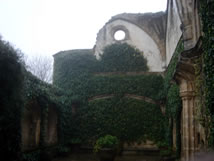 |
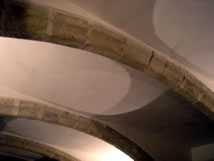 |
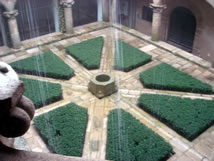 |
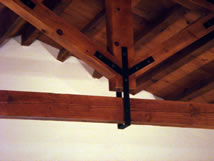 |
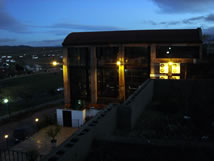 |
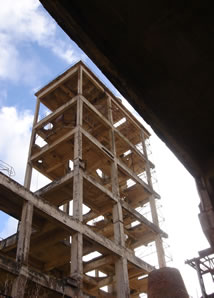 |
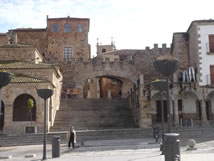 |
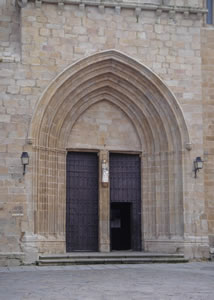 |
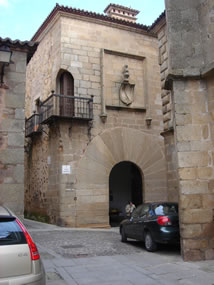 |
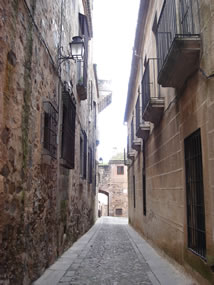 |
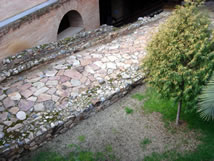 |
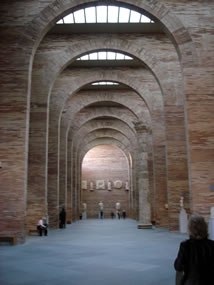 |
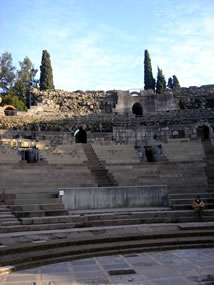 |
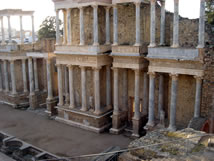 |
 |
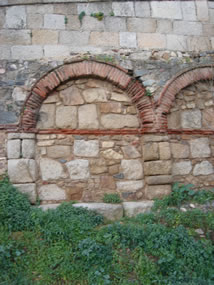 |
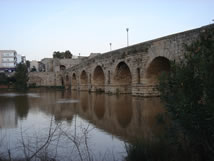 |
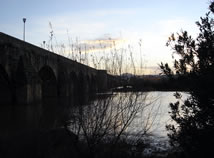 |
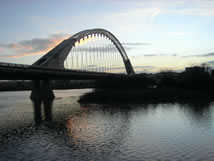 |
| This region, it can be said, is making the transition from Medieval-Renaissance-Revolution to post-modern times in two generations. This is both a challenge and an almost unprecedented opportunity. Here is an entire region of a country uncluttered by the poor development patterns of the last decades. Our host can remember traveling, as a child, by car and the only crossing over a major river was a bridge, pictured above, built by the Romans nearly 2,000 years ago. If there was a truck on the bridge only one way traffic at a time was possible. This bridge carried car traffic until just a few years ago, a tribute to Roman engineering. There are three bridges today including one built, in the 1980s, by the Great Spanish architect Santiago Calatrava [link: santiago calatrava] near the Roman one which is still used as a foot bridge. These two bridges in sight of one another make a fitting symbol of the crossing between the historical Spain and the new Spain. The region is connected, now, by well built two lane highways. It is a region rich in resources and talent. It has a great architectural legacy although the majority of recently built buildings are yet to find their own architectural voice nor do they connect back to the past in a comfortable way. Yet, this remains a landscape largely unsullied by the too rapid, exploitive development that can be seen in much of the West and now around many parts of the world. Craft is still alive and there is an abundance of industrial talent as well. The region is now attracting software developers who, independent of location, what to live in a place with greater amenity - let us hope that this quality, now suddenly so precious to people, is not destroyed by its own success. Will this region remain a supply economy or become a viable 21st Century replacement economy? Will it keep its heritage while forging a new one? What a challenge. What a chance to think all this through and create something better and more sustainable than has been done before. What a history to build on - what an opportunity to do so without being trapped by it. |
...Week Four - 11/Feb to 17/Feb/07
Connections and Reconnecting |
| Gail and I arrived in Torino on Sunday, February 11th, and then she left Tuesday to go to Zurich and return to Elsewhere. Sunday evening I showed her the NavCenter and on Monday afternoon Dario and Paula provided a tour of the third floor Learning lab portion of the UniManagement facility. On Monday and Tuesday mornings, we enjoyed two field trips with Paola and Dario the first to the Biblioteca REALE where we were able to see original drawings and a Codex by Leonardo. |
| What can I say? To see a reproduction of Leonardo’s work is one thing. To see it in the flesh is an entirely other experience. In drawing there is a term, hand, which refers to the unique way a person draws. This goes way beyond the literal drawing ability displayed (although Leonardo was a master at this skill) - it refers to the touch and energy, the meaning that is fused into the paper. Here before your eyes is a drawing, hundreds of years old, that lives - that pulsates with the energy of a perception - capturing the essence of both subject and creator at one moment in time. |
| The Codex, Codice sul volo degli uccelli, was a bound notebook that Leonardo kept with him for many years until his death. It was his studies of flight - both of birds and the potential of mechanical. Here you see the absolute fusion of artist, scientist and inventor - the true Renaissance person - and a measure of what we have fragmented in our own times. |
| The Biblioteca REALE, itself, is a work of art and has its own story [future link]. My photo, above, is of the main reading room. Besides storing many historical works and displaying works of art, it is an active working environment for scholars. Several were there, doing research, reading, photographing and coping from old manuscripts. Thus this room, today, is actively fulfilling the purpose for which it was conceived long ago. Design/Build/USE. This is reassuring in our “instant” society. It is also a shocking reminder that I live in a country where it’s President, and his administration, can sneer at “old Europe” without even a little negative feedback from the American people. Cannot the chauvinism and danger of this attitude be perceived and met with a firestorm of objection? Oh well, we have God and the US Army on our side. What happened to Rome, one wonders. |
| Tuesday held store another adventure into the past and its living present with a visit to the Museo Nazionale just reopened after extensive work. |
The Museo Nazionale is full of treasures however here I will focus on its architecture. Like many of the buildings we saw in the last two weeks it is build on the foundations of a Roman work. We spent about three hours in the building which allowed us to basically walk it and get a sense of its structure and contents. The first thing to realize is that here is a building that has been used, altered, added to and rebuilt for centuries. It has Roman, Medieval, Renaissance and, at this point, largely Baroque elements all, now, with the careful insertion of modern technology.
It is interesting to note that the character and amenity of old buildings changes significantly with modern technology properly applied - in this case, accomplished in a very transparent way. From Medieval to the late 19th Century, buildings could not have been very comfortable. Roman technology, at its best, would have been better with running water and in-wall/floor heating. What is clear is that these older works did adapt better to weather and lighting requirements, sans technology, in terms of the basic structure than most modern ones which rely too heavily on technology. Tall ceilings, good ventilation, courtyards and solid materials were abundant. In many respects, they were much greener than the majority of contemporary built works. It is actually the Victorian era that proliferated overfilled, fussy, stuffy rooms.The combination of old architecture and modern sanitation, technology and transportation can be outstanding and calls for reexamining the value of these pieces. It should be noted, however, that these works were only for the very wealthy. In the case of what we are looking at here, the King. While their economy, symbol and architectural grammar may not be fit for our time, two things are true: their command of architectural technique and skill of building is far superior to the vast majority of modern works - whatever the budget - and if properly retrofitted, they can have a useful life today for specific purposes.
There is something about what time does to a properly designed and built work of architecture that provides a quality that no new structure can match. This quality needs to be better understood and we need to understand better how buildings weather, age and adapt, and incorporate this in our modern works. |
|
|
|
|
|
|
|
| The propaganda promoted in the early days of modern architecture was that the architectures of the past were largely without value and had little relevance in the modern world. This was, I think, “necessary” in order to break the grip of the old ways and open the field for the new. We through the baby out with the bath water and this is unfortunate. |
| The UniManagement environment successfully integrates three distinct architectural periods into one hamoneous functional whole. Each of these architectures are embraced and made better by the presence of the others. They, together, make a statement about the past, present and future. |
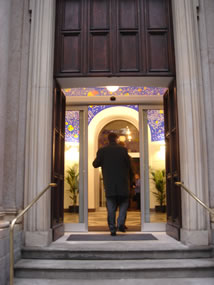 |
Three architectures working together to create a constantly changing landscape for creative action.
It is difficult to see this integration from pictures because the camera cannot show what the human eye can see and they do not adequately provide the sense of space and feel of materials as they actually exist. In reality, all three architectures: the original classical shell, the contemporary work of glass and steel, and the wood of the organic NavCenter Armature, floor and WorkFurniture can be seen together no matter where you stand.
One of the goals of this architecture is to remind people WHO they are - in terms of their best sense of themselves - and WHERE they are - in terms of place, city region and world - yet, to do this while not triggering memories of workplaces which only obstruct the free flowing exercise of their creative capabilities [link: a manifesto]. PLACE is necessary and so is historical context - symbols that trigger not-useful reactions and habits are not wanted [link: the 22 aspect of memory]. There is nothing conventional about the totality of this environment yet history is respected [link: unicredit navcenter tour]. It is also a requirement of the function of the NavCenter that, when inside working, people lose the overwhelming presence of the world from which they came. The NavCenter has to create a reality sufficient to function on its own for an extended period of time. It is in this exciting yet safe place - that represents the best past, present and future, that we can make possible - in which people are challenged to learn and recreate their preferred future. In the world they normally work in the overwhelming environmental (physical place, work process and tools) context encourages the status quo and at best improvements on a future that is already designed by default [link: a future by design not default].
Everything “speaks” every thing is embedded, manifested idea. It is interesting that Verlyn Klinkenborg would write the following: Letter From California: Looking for the Pattern of Ordinary Life about Southern California which is a place at once so rich and yet so indistinct. What have we done to ourselves? It could be credibly argued that Southern California has the richest collection of modern architecture that exists in any one place as well as a heritage that goes back to Spanish times [link: esther mccoy five california architects]. Yet, so much of the armature is shattered. What is this experience and what does it mean? How does it affect health, work and humanness? How did it come about? What will facilitate its change? What will another generation of signature buildings by star architects combined with mundane commercial workspaces and homes add up to?
I refer to the NavCenter as a landscape for work and I do not mean this as a metaphor. The variety of people who will work here - their skills and preferred cognitive modalities - and the scale and scope of the challenges they will engage - from learning to design and from local to global issues - requires a place that is as variegated as they are and what their work demands. This is an issue of requisite variety [link: ashby requisite variety] not esthetic opinion.
It is best to think about the requirements of an effective NavCenter as being exactly those of a viable city - the same pattern language and ecology-economics are involved - they are just exercised on a more intimate level of recursion. Not only it this necessary, functionally, for the NavCenter to operate as it should, it also is a direct expression of the key aspects of the Taylor Method which artfully employ the principles of iteration, recursion and feedback link: taylor method table 2] to promote systematic emergence [link: zone of emergence engine].
The economics of this NavCenter “city” have to be what Jane Jacobs calls a replace economy [rbtf book: cities and the wealth of nations]. They have to be able to reinvent themselves and their economic basis as required by changing circumstances. The must function and have all of the characteristics of a replacement economy and bring the principles of a replace economy to their users in a way that allows them to embed them into their solutions. A NavCenter which lives only by corporate patronage will soon grow stale and die. |
|
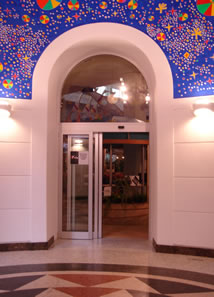 |
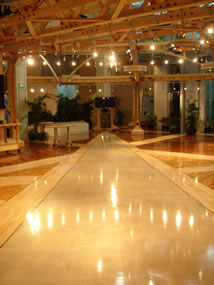 |
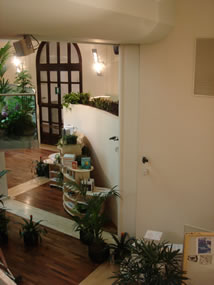 |
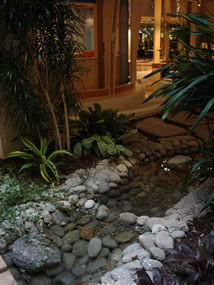 |
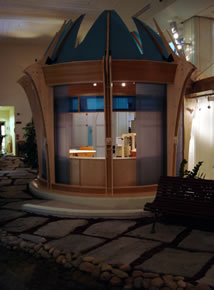 |
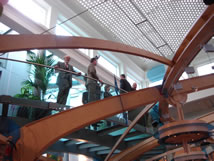 |
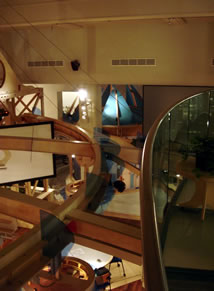 |
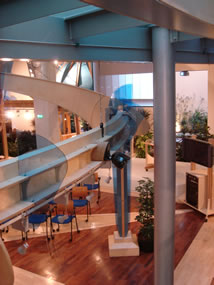 |
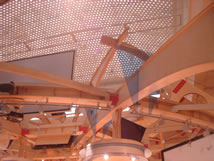 |
| In my mind, some of the best architecture being done today is produced in the circumstance of re-purposing and retrofitting older buildings. I have long wondered why. I think it is because of three factors: first, the constraints put in place by the older building; second, the fact that older buildings make good armatures [link: an armature way of building]; and third, the material qualities of both the old and the new compliment one another by contrast. We do steel and glass very well today. We do not do stone, brick and wood well because we try and turn them into an industrial product without understanding the consequences [link: ochshorn - designing building failures]. This can work - if correctly done - with wood laminations if properly scaled. The quality of the old materials is best achieved when built the old ways - something that our society seems to believe (falsely, I think) we cannot afford to do today. The old materials age well. The hold their history. They can be repaired. They make Pattern language [link: pattern Language] easy to achieve. This tradition of working old and modern building technology together to create something with the best of both goes back to the great French architect Viollet-le-Duc [link: viollet-le-duc - wikipedia] who was a strong influence on the entire first generation of modern architects. |
| On Wednesday, I had one of the most enjoyable experiences that I can remember. I met the photographer Maurizio Galimberti [link: instant artist]. We had a conversation about his unique style and use of Polaroid, I showed him the NavCenter and then he composed - created is a better word - a portrait of me. This was a pleasant sitting and unlike anything I have ever experienced. The resulting work will hang in the NavCenter and what is below are the 111 shots as he placed them in the order of shooting. The shooting took about a half an hour and the composition, when he put the Polaroids on the table, unfolded in front of our eyes in a matter of seconds. The idea of his portraits is to capture his subject in a deep, multidimensional way - at an instant in time - so the the memory of that time and place can be experienced later - in retrospect - and the emotion of the time recalled. I am sure he accomplished this for me. The idea to do this came form Dario and it certainly was a great gift. Galimberti’s way of work is direct and takes both great conceptual and compositional skill and also an incredible ability to choose his shots quickly and with precise alignment. He does all this is a way that also makes his subject comfortable yet aware of the process. This is different from the usual “passive” sitting. You feel that you are part of making a piece of art and it is almost irrelevant that you happen to be the subject material out of which the final result emerges. |
|
by Maurizio Galimberti
© 2007 - all right reserved |
| During our various times together, this week, Paula, Dario and I discussed the first six months of the NavCenter and the details of the transfer process. Much of this discussion was based on work that Lisa has been doing over the last three months. On Thursday, we worked for several hours and outlined the foundation for a strategy of how to achieve the transfer of the Taylor Method to UniManagement and employ the facility on the three critical levels of recursion it was designed to function on. This included how to incorporate the growing ValueWeb of existing and becoming Centers and KnowledgeWorkers so that Unimanagement is appropriately connected from the beginning. We organized an agenda of the use of my time until I return to the States at the end of February. The implementation process started Friday and this is documented in the next section of this narrative (see link below). |
|
| After the Leadership Meeting through the first half of February I had a series of experiences: DAVOS as a true participant; the introduction of the UniManagement facility to Torino; the trip to Spain to see Gaudi and the Extremadura Region; upon returning, the visits to the Biblioteca and the Museo Nazionale; the photo experience with Maurizio Galimberti and the beginning of the formal transefer process to UniManagemet staff. This has taken a month. It is safe to say, that I have exercised more leisure (in the true and original meaning of the concept) in this period than in total over the last decade. The making of the UniCredit NavCenter was the most demanding task of my 50 years of work. The period of leisure, afterward, has been equally “demanding” in a totally different way - a life changing way. A way that has brought to resolution many issues and conflicts. A way that opens the door to the transfer process at Unimanagement and the other projects now waiting in the wings. I will describe this in more detail elsewhere [june 16, 2007]. Suffice to say that the entire past of my professional efforts is PAST and I am at a new beginning now. The game has shifted. There remain challenges, successes and failures, good times and disappointments - yet, the old battles are over. My priorities and use of myself has changed. It is time now to go out into the World and bring this work to the world. |
| I am convinced, by my experiences - since the opening of the UniManagement facility - that the NavCenter must, can and will develop to its full potential. To reach its potential value to UniCredit requires this. So does accomplishing its potential to serve Torino. Its natural role as flagship of a network of NavCenters mandates it. The time has come and the right tool has been built in the right way in the right place. Past present and future merge here. The window is open. There is need and demand for what a capacity like this can do. The task ahead is to implement. That is what these first 6 months are about. |
| One of the habits of creative people [link: 22 creative habits to embedded rules] is to know when to walk in the park. Over this last 30 days I have walked” more than I have in a long, long time. This has been a good re-membering. This walk in the park was not unrelated to my work - I am not capable of this. Yet is was a recreation [link: 4 step recreation model] of my work. This has enabled me to bring back a fresh point-of-view to the UniCredit project and to the other works which are immediately ahead. Had I done this earlier it would have been detrimental to finishing the NavCenter for this required an intense unrelenting project management focus. Had I not done it immediately afterward, it would have been disastrous to the work which is important now for these efforts require a different energy and perspective. And, I might well have not realized that the social factors that impact my work most have shifted. |
| There are in reality only a few things we humans can do for each other. We can be companions. We can offer spiritual and emotional support in time of stress. We can provide material things by giving or performing useful work. We can make art which enlightens and inspires. We can teach each other and codify knowledge in various formal ways and this sometimes requires enforcing a discipline. Of all these, I think the greatest gift - which requires all of the others - is to document one’s life in a way that another can gain some value from it. Life is reality. Our experience is the only truth we know. This is why I have chosen, in this Notebook, to offer my work and the meaning of it in an intensely personal way. What I think, feel or do will not work for you. It may trigger something within you to facilitate the memory of what you already know and may have forgotten. It may encourage you to “step up” to your highest ideal and potential. If so, the effort required to live, work and document a reflective, principled life will have value beyond just what it has provided me. If these fragments simulate you - not to “believe” them, but - to recreate these descriptions of my experience in a way useful to your art whatever it is, I will have succeeded in my purpose. I will have passed on the gift given to me by so many who came before and left a record of a world-that-could-be which transforms the one of our common experience. |
| There will be those who will say that I am too idealistic and not practical. This whole web site is a documentation of the process of learning how to fuse the ideal and the practical. I am a builder not a dreamer. I will also comment that when a civilization - if you can call us civil - obtains the kind of power that we have, it is a survival imperative to shed this false dichotomy between the ideal and the practical. Our own shattered past is testimony to this. I will not comment on the millions of people still being slaughtered, today. One can only wonder, when we are allowed access to the stars, how many destroyed planets we will see as stark, mute museums to those who refused to learn [why space?]. If you want to have god-like powers it is prudent to shed child-like behaviors. I have no idea if we will. I can only do my small part by building a tool that can facilitate a necessary shift. Meantime, this tool is very practical for dealing with the issues of the here and now that each owner-organization faces. This strategy seems practical to me. I think it is the majority of our kind who are doing the dreaming. |
|
LINK to the rest of UniCredit NavCenter - February 07 |
|
| GoTo: UniCredit Handwritten Notebook |
|
|
|
|
| GoTo: Unicredit NavCenter Tour |
|
|
|
|
| GoTo: Unicredit NavCenter Tour |
|
|
|
Matt Taylor
Barcelona
February 6, 2007
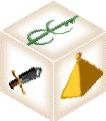
SolutionBox
voice of this document:
BUILD • TACTICS •
EVALUATION
|
posted:
February 6, 2007
revised:
February 17, 2007
• 20070106.982821.mt • 20070208.321432.mt •
• 20070213.565656.mt • 20070216.678100.mt •
• 20070217.760192.mt •
(note:
this document is about 90% finished)
Copyright© Matt
Taylor 2007
photo of Matt Copyright© Maurizio Galimberti 2007
|
|
|